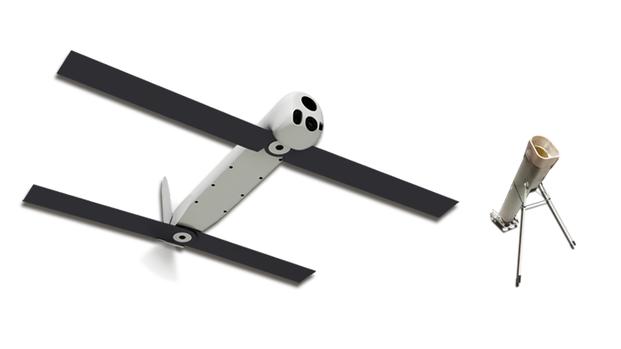Will 2016 be the year of the portable lethal drone?
As I found when writing my new book, "Swarm Troopers," these weapons, also known as loitering munitions, have been quietly maturing over the last few years. Thousands have already been fielded in Afghanistan. They have now reached the point of breakout. This is no longer a field dominated by the U.S.; few nations have the resources to build a stealth bomber, but literally anybody can make a small drone, and some are already in production.
In the U.S., the Lethal Miniature Aerial Munition System is only progressing slowly towards becoming a program of record. This is in spite of the successes achieved by the successful fielding of Switchblade drones under the program.
Made by AeroVironment Inc., the Switchblade weighs less than five pounds and its electric propulsion is near-silent. It is tube-launched, with flick-out wings, and can fly for more than ten minutes, sending back color video and infra-red imagery so the operator can locate and identify a target. Once spotted, it can lock on and dive in at over 90mph with a warhead powerful enough to take out a pickup truck or a group of individuals with pinpoint precision from six miles away.
%embed1%
Being able to find and hit targets miles away from behind cover with high accuracy could alter ground combat. A squad with this capability could decimate opponents at long range without ever being seen. Switchblade can also be launched from an aircraft or even a submarine for covert strike.
The drone has received little attention compared to bigger drones like the Reaper. Few realize that over four thousand Switchblades have been deployed in Operation Enduring Freedom in Afghanistan. Switchblade has been commended for its accuracy, being able to hit snipers from behind cover, as well as picking out single insurgents in a crowd of bystanders.
While Switchblade is the obvious contender for LMAMS, there is competition. Textron Inc. is putting forward its Battlehawk, and Lockheed Martin Corp. in contention with Terminator. The original Terminator looked like a miniature twin-engined WWII bomber, but Lockheed Martin recently unveiled a new version to better fit the LMAMS requirements.
 Lockheed Martin Corp.'s Terminator unmanned aerial vehicle. (Photo courtesy Lockheed Martin Corp.)
Lockheed Martin Corp.'s Terminator unmanned aerial vehicle. (Photo courtesy Lockheed Martin Corp.)
"Terminator now collapses into a compact configuration readily capable of tube launch," says a spokesman. "The missile preserves the general size, shape and aerodynamics of its original high performing and proven airframe design, but now gives the soldier a more man-portable and convenient deployment method."
Unusually, there is also a foreign company in the running for LMAMS. Israeli company uVision makes the Hero range of loitering strike drones, and the smallest, the Hero-30, fits the requirements for LMAMS. UVision president and CEO Yair Dubester has stated that the company will be competing for LMAMS with the help of an established US missile firm.
The Hero range have already been sold to an Israeli military customer, and there are understood to be two other confirmed but unnamed customers. In addition, the company has offered licenses to manufacture the Hero to other companies. Israel has long led the U.S. in drones.
 Man-pack portable, Hero 30 is the smallest system in the UVision family of smart loitering systems. (Photo UVision Air Ltd.)
Man-pack portable, Hero 30 is the smallest system in the UVision family of smart loitering systems. (Photo UVision Air Ltd.)
More surprisingly, a Polish company, WB Electronics, also offers a lethal drone. The Warmate is larger than the size specified for LMAMS at nine pounds, but it has a 30-minute endurance and a maximum speed of 90 miles per hour. There are two different warheads, an anti-personnel fragmentation charge and a shaped-charge warhead. The first version is claimed to have a lethal radius of ten meters, while the second can penetrate 100mm of steel armor. Unlike other infantry weapons, a drone can easily attack the top, rear or sides of a vehicle. In September, WB told Janes that Warmate was already in production for an un-named Asian customer.
Iran is also active in this field. The Iranians manufacture a bewildering variety of drones of all shapes and sizes, and recently have been developing them for attack missions, carrying missiles or kamikaze-style warheads, and larger Iranian drones have apparently been used to target rebels in Syria. Given that the country already makes small hand-launched drones like the Faraz 2 and Black Eagle, it seems likely that Iran will develop portable attack drones if there is a requirement.
Perhaps the most alarming development the use of homemade drones packed with explosives against a Kurdish group in Syria. Two such flying improvised explosive devices, or IEDs, were apparently brought down by Kurdish YPG fighters, who claim they were sent by ISIS. The drones appear to be based on the Skywalker X9 airframe, a hobby drone with a nine-foot wingspan and which ISIS has used previously for reconnaissance missions.
This highlights the fact that in 2016, almost anyone can make an attack drone. Previously, you had to be a hobbyist to build and fly a radio-controlled aircraft, and it took time and skill. Crashes were part of the learning process. Now companies like DJI market camera-carrying quadcopter drones that can be flown right out of the box by beginners, complete with stabilization and automated GPS waypoints. Around a million quadrotor drones were sold last year.
The consumer market is currently dominated by quadrotors, but at the recent Consumer Electronics Show, Parrot unveiled a new drone called Disco. Parrot are famous for the AR Drone, a popular quadrotor which can be flown from a smartphone. The Disco aims to achieve the same success with a fixed-wing design, giving much greater speed (50 mph) and endurance (45 minutes), and a stabilized HD video camera. Disco weighs a pound and a half and the flying is highly automated with no piloting skill needed; once tossed into the air it starts circling and waits for instructions.
The ready availability of this type of technology blurs the line between military and commercial electronics. There is a vast amount of technology from the mobile phone world -- for example, in the field of object recognition -- which is likely to be taken up by drones. 2016 is likely to see an accelerating arms race in this field. Expect to see rapid evolution, and a sharp improvement in the capabilities of lethal loitering drones.









